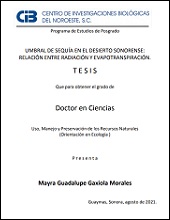| dc.contributor.advisor | Brito Castillo, Luis | |
| dc.contributor.author | GAXIOLA MORALES, MAYRA GUADALUPE | |
| dc.date.issued | 2021 | |
| dc.identifier | https://cibnor.repositorioinstitucional.mx/jspui/handle/1001/2429 | |
| dc.identifier.uri | http://dspace.cibnor.mx:8080/handle/123456789/3082 | |
| dc.description.abstract | "La sequía es un fenómeno anómalo que se caracteriza por déficits en la precipitación durante un periodo extendido. La temperatura superficial, que es modulada por al menos tres factores: la rugosidad del terreno, la radiación y la evapotranspiración, está asociada a la ocurrencia de sequías. El factor de radiación implica que, al incrementarse el albedo, la radiación absorbida por la superficie disminuye, enfriándola, resultando en una relación inversa albedo–temperatura. Esta relación es válida sólo en desiertos con valores altos de albedo y poca vegetación como ocurre en el Desierto Sonorense. El factor de evapotranspiración involucra a la vegetación. En el proceso de deshidratación de la vegetación la superficie se vuelve menos opaca y con valores cada vez más altos de albedo; al irse deshidratando la vegetación absorbe cada vez menos radiación y ésta pasa directamente a la superficie, calentándola. Por lo tanto, el factor de evapotranspiración implica una relación directa albedo–temperatura. Utilizando valores calibrados mensuales de imágenes de satélite de albedo, temperatura superficial y el Índice de Vegetación de Diferencias Normalizadas (NDVI), para el periodo febrero/2000–febrero/2018, con resolución espacial de 0.05 × 0.05° (~5.6 km) en cinco cuadrantes de 1°× 1° cada uno, se analizaron a detalle las relaciones albedo–temperatura superficial en el Desierto Sonorense. Las relaciones encontradas entre albedo–temperatura superficial y valores sobrepuestos de NDVI ayudaron a esclarecer la respuesta no lineal de la vegetación, y elucidar los valores umbrales de NDVI, representativos del límite en el que la vegetación muestra condiciones hacia una deshidratación severa. Se encontró que valores umbrales de NDVI de <0.10 son típicos de las zonas más áridas de los cuadrantes situados en el centro de Baja California y en el sitio del Patrimonio de la UNESCO El Pinacate y Gran Desierto de Altar (cuadrante 2 y 5 respectivamente). Las zonas más húmedas, en el sur y en el centro de la península de Baja California, y en la llanura costera de Sonora, experimentan valores umbrales de NDVI de <0.15 (cuadrantes 1, 3 y 4, respectivamente). El ciclo anual de las series de albedo, temperatura superficial, NDVI y precipitación revelaron que los periodos más propensos a condiciones climáticas desérticas (es decir, más cálidas y secas) son para el mes de junio en los cuadrantes 1, 2, 4 y 5, y en noviembre-febrero en cuadrante 3..." | es |
| dc.format | pdf | es |
| dc.language.iso | spa | es |
| dc.publisher | Centro de Investigaciones Biológicas del Noroeste, S.C. | es |
| dc.rights | Acceso abierto | es |
| dc.subject | Albedo, Temperatura Superficial, NDVI, Valor umbral | es |
| dc.subject | Surface temperature, NDVI, Threshold value | es |
| dc.subject.classification | CLIMATOLOGÍA REGIONAL | es |
| dc.title | UMBRAL DE SEQUÍA EN EL DESIERTO SONORENSE: RELACIÓN ENTRE RADIACIÓN Y EVAPOTRANSPIRACIÓN | es |
| dc.type | doctoralThesis | es |
| dc.dirtesis.grado | Doctorado en Ciencias en el Uso, Manejo y Preservación de los Recursos Naturales | es |
| dc.dirtesis.disciplina | Ecología | es |
| dc.dirtesis.universidad | Centro de Investigaciones Biológicas del Noroeste, S.C. | es |
| dc.dirtesis.facultad | Posgrado en Recursos Naturales | es |
| dc.description.abstracten | "Drought is an anomalous phenomenon characterized by deficits in precipitation over an extended period. Surface temperature, which is modulated by at least three factors: terrain roughness, radiation and evapotranspiration, is associated with the occurrence of drought. The radiation factor implies that as albedo increases, the radiation absorbed by the surface decreases, thus cooling the surface and resulting in an inverse albedo-temperature relationship. The radiation factor is valid only in deserts with high albedo values and few vegetation, as is the case in the Sonoran Desert. The evapotranspiration factor is related to vegetation. In the process of dehydration, the surface becomes less opaque with increasingly higher albedo values; in this case the vegetation absorbs less and less radiation and consequently the radiation passes directly to the surface, heating it. Therefore, the evapotranspiration factor implies a direct albedo-temperature relationship. Using monthly calibrated satellite image values of albedo, surface temperature and Normalized Difference Vegetation Index (NDVI), for the period February/2000-February/2018, with spatial resolution of 0.05 × 0.05° (~5.6 km) in five squares of 1°× 1° each, the albedo-surface temperature relationships in the Sonoran Desert were analyzed in detail. The relationships found between albedo and surface temperature, and overlapping NDVI values, helped elucidate the nonlinear response of vegetation, and to determine threshold NDVI values, representative of the limit at which vegetation shows severe dehydration conditions. Threshold NDVI values of <0.10 were found in the driest areas of the squares located in central Baja California and in the UNESCO World Heritage site El Pinacate and Gran Desierto de Altar (squares 2 and 5, respectively). The wettest areas, in the south and center of the Baja California peninsula, and on the Sonoran coast, experienced NDVI threshold values of <0.15 (squares one, three and four, respectively). The annual cycle of albedo, surface temperature, NDVI, and precipitation series revealed that the periods with increasing drought conditions (i.e., warmer and drier) correspond to June in squares 1, 2, 4 and 5, and to November-February in square 3. The results of this research could be of interest to decision-makers concerned with drought monitoring, and for the development of improved management and conservation practices in the Sonoran Desert." | es |

